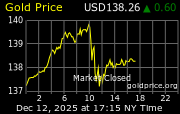Gold have also succumbed to profit-taking as Chinese participants returned to the market
 Along with the other metals, Gold have also succumbed to profit-taking as Chinese participants returned to the market. Downward momentum has continued into this morning, with European markets adopting a risk-off stance. Currently, US equity futures paint a similar picture for US markets, and as such, we expect precious metals to encounter further downside as the day progresses.
Along with the other metals, Gold have also succumbed to profit-taking as Chinese participants returned to the market. Downward momentum has continued into this morning, with European markets adopting a risk-off stance. Currently, US equity futures paint a similar picture for US markets, and as such, we expect precious metals to encounter further downside as the day progresses.Net speculative length for COMEX gold grew, with 29.0 tonnes added last week — the largest gain of the year so far. The change in the net position was largely the result of speculative longs being added (26.0 tonnes). After three weeks of improvement, the net position at 498.4 tonnes is still well below last year’s average of 671.3 tonnes. While these improvements are encouraging, their tentative nature indicated a speculative market that remained not entirely convinced of gold’s short-term prospects ahead of the Fed’s announcement. ETFs added 17.3 tonnes of gold, the strongest weekly rise since mid-November 2011.
Looking ahead to the coming week, the U.S. economic calendar is filled with data points that are likely to influence the price of gold. The PCE Price report, the Fed’s preferred measure of inflation, is due out Monday morning, followed by the Case-Shiller housing report, the Chicago Purchasing Managers’ Index, and Consumer Confidence on Tuesday. Wednesday’s itinerary includes the ADP employment report, as well as the ISM Index – a key gauge of manufacturing activity. Weekly jobless claims are scheduled for Thursday, followed by the critical non-farm payrolls and unemployment data on Friday.
While the Fed already revealed to the market its plans for monetary policy over the next several years, this week’s economic reports could serve to reinforce the central bank’s extremely dovish stance. If the data continues to indicate sluggish growth and challenging labor and housing markets, the gold price is likely to remain well supported. However, if the reports come in ahead of economists’ estimates, Gold may give back a portion of the substantial gains it has generated this month.





























